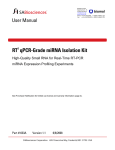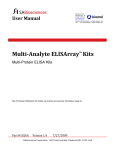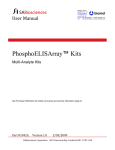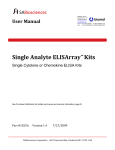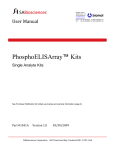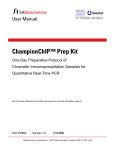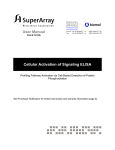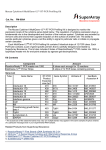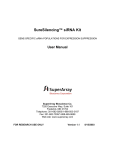Download User Manual - Biomol GmbH
Transcript
Bioscience Corporation BIOMOL GmbH Waidmannstr. 35 22769 Hamburg [email protected] www.biomol.de Phone:+49-40-8532600 or 0800-2466651 (D) Fax: +49-40-85326022 or 0800-2466652 (D) User Manual 2 RT qPCR-Grade RNA Isolation Kit High-Quality Total RNA for Real-Time RT-PCR Gene Expression Profiling Experiments See Purchaser Notification for limited use license and warranty information (page 3). Part #1027A Version 1.2 2/15/2008 2 RT qPCR-Grade RNA Isolation Kit High-Quality Total RNA for Real-Time RT-PCR Based Gene Expression Profiling Experiments User Manual (For Catalog Number: PA-001) Ordering and Technical Service Contact Information: • • • • Tel: Fax: On-line Order: E-MAIL: 1-888-503-3187 (US) 301-682-9200 (outside US) 1-888-465-9859 (US) 301-682-7300 (outside US) www.superarray.com [email protected] (to place an order) [email protected] (for technical support) You may place orders by fax, e-mail or from our website. Each order should include the following information: • • • • • Your contact information (name, phone, email address) Product name, catalog number and quantity Purchase order number or credit card information (Visa or MasterCard) Shipping address Billing address For more information, visit us at www.superarray.com BIOMOL GmbH Waidmannstr. 35 22769 Hamburg [email protected] www.biomol.de Phone:+49-40-8532600 or 0800-2466651 (D) Fax: +49-40-85326022 or 0800-2466652 (D) SuperArray Bioscience Corporation 7320 Executive Way, Suite 101 Frederick, MD 21704 USA CONTENTS I. Background and Introduction 4 II. Materials Provided 5 III. Additional Materials Required 5 IV. Protocol 6 A. Sample Preparation 7 B. Total RNA Isolation 9 C. Quality Control 11 V. Troubleshooting 11 LIMITED PRODUCT WARRANTY This product is intended for research purposes only and is not intended for drug or diagnostic purposes or for human use. This warranty limits our liability to replace this product in the event the product fails to perform due to any manufacturing defect. SuperArray Bioscience Corporation makes no other warranties of any kind, expressed or implied, including without limitation, warranties of merchantability or fitness for a particular purpose. SuperArray Bioscience Corporation shall not be liable for any direct, indirect, consequential or incidental damages arising out of the use, the results of use or the inability to use this product. NOTICE TO PURCHASER The purchase of the RT2 qPCR-Grade RNA Isolation Kit includes a limited, nonexclusive license to use the kit components for research use only. This license does not grant rights to use any kit component for reproduction of or modification for resale or to use the RT2 qPCR-Grade RNA Isolation Kit to manufacture commercial products without written approval of SuperArray Bioscience Corporation. No other license, expressed, implied or by estoppels, is granted. 2 RT qPCR-Grade RNA Isolation Kit I. Background and Introduction Real-time reverse transcription (RT) PCR is the most sensitive and reliable method for gene expression analysis. Its wide dynamic range makes real-time RT-PCR the preferred choice for the simultaneous quantification of both rare and abundant genes in the same sample. However, one of the most important challenges for achieving accurate and sensitive gene expression analysis by real-time RT-PCR is the quality of the input RNA material. Many common impurities in RNA preparations interfere with reverse transcriptase activity. Degraded RNA performs poorly in reverse transcription by generating shorter cDNA templates. Low cDNA yield, in turn, results in poor RT-PCR sensitivity. In addition, minimizing or eliminating genomic DNA contamination is also essential for obtaining accurate gene expression with real-time RT-PCR to avoid the production of non-specific secondary products and the detection of false positive signals. SuperArray’s RT2 qPCR-Grade RNA Isolation Kit is optimized for real-time RT-PCR based gene expression analysis. It is designed to extract total RNA that is free of genomic DNA and other impurities from typical quantities of biological source material. This kit prepares up to 100 µg of total RNA directly from transformed animal cell lines or is used in combination with a phenol/chloroform-based extraction method to isolate high quality total RNA from animal tissues. The kit also includes a step that very effectively eliminates genomic DNA contamination from RNA samples during the isolation procedure. The special silica membrane Spin Column technology used in the kit makes the procedure fast and easy to perform with less than 30 minutes of hands-on time at room temperature. The lysis buffer, with its chaotropic components, stabilizes RNA, prevents its degradation by inhibiting RNase activity, and optimizes the conditions for its retention on the spin column. An on-column treatment with an RNase-free DNase enzyme specifically digests genomic DNA into material unable to bind the column, while leaving the retained RNA perfectly intact. The Washing Buffers remove the degraded genomic DNA, salts, metabolites, and macromolecular cellular components. Low ionic strength conditions elute pure RNA from the column. The RNA is then ready for subsequent cDNA template synthesis using the RT2 First Strand Kit (C-03). 2 Benefits of the RT qPCR-Grade RNA isolation Kit: High Quality and High Yield: Isolate enough high-quality RNA directly from crude cell and tissue lysates with a protocol optimized for real-time RT-PCR gene expression analysis. Reliable and Sensitive: Find more genes expressed at lower levels while eliminating false positives. Fast and Convenient: Go from as many as 12 samples to purified RNA with less than 30 minutes of hands-on time. Technical Support: [email protected] 4 www.superarray.com Version 1.2 II. Materials Provided: This kit includes enough of the following reagents to isolate total RNA from 12 samples: TUBES AND CONTENTS BOX 1 RNase-free DNase (rDNase) DNase Reaction Buffer BOX 2 Lysis and Binding Buffer (G6) Desalting Buffer (G15) Pre-wash Buffer (G16) Washing Buffer (G17: Add 10 ml ethanol before use.) RNase-free H2O Spin Columns (12) Collection Tubes (36) Filter Columns (12) Elution Tubes (12) BOX 1 is shipped on blue ice packs or dry ice and should be stored at -20 °C upon receipt. BOX 2 is shipped at ambient temperature and should be stored at room temperature. All reagents are stable for 6 months after receipt of the kit if stored at the recommended temperature. III. Additional Materials Required: The following supplies are also required but are not included in the kit and must be purchased separately from other manufacturers: TRIzol® (Required for tissue samples, Invitrogen, Cat. No. 15596-026) Chloroform, isopropanol (for use with TRIzol®) RNase-free 1.5-ml and 2-ml microcentrifuge tubes RNase-free pipette tips 70% and 100% ethanol, molecular biology grade Micro-cuvettes and a spectrophotometer Bench-top Micro-Centrifuge Technical Support: 888.503.3187 5 301.682.9200 2 RT qPCR-Grade RNA Isolation Kit IV. Protocol: Notes on Sample Preparation: The protocol for sample preparation depends on the nature or source of the sample itself, whether tissue, cultures cells, or a previously prepared sample of RNA requiring further purification. Follow the appropriate protocol below for your biological source material. 1. Preparing Animal Tissues for Total RNA Isolation: Many animal tissues contain difficult to remove contaminants (such as polysaccharides, fats, lipids or fibrous components) that may interfere with subsequent enzymatic reactions if not removed from the RNA preparation. We recommend homogenizing animal tissue and then performing a phenol/chloroform extraction using the TRIzol® reagent (Invitrogen) prior to proceeding with the RT2 qPCR-Grade RNA Isolation Kit protocol. A brief protocol for the TRIzol® procedure is given in the next section; however, first-time users should also refer to the original manufacturer’s suggestions. 2. Preparing Cultured Animal Cells for Total RNA Isolation: For cultured or freshly isolated animal cells (such as peripheral blood lymphocytes), homogenization or phenol/chloroform extraction is not necessary. Cells may be harvested by trypsinization (for adherent cells) and / or centrifugation, and then used directly in the procedures in the next section. 3. Preparing Previous RNA Isolations for Cleanup The RT2 qPCR-Grade RNA Isolation Kit may also be used to clean up previously generated RNA preparations for use in relative gene expression profiling experiments. Such preparation may include RNA isolated by methods other than those mentioned here, such as intact RNA that performed poorly in a downstream enzymatic reaction or RNA that is otherwise crude for some reason. These RNA samples may also be used directly in the procedures in the next section Notes on Solution Preparation: Washing Buffer (G17) is supplied as a concentrate. Before using for the first time, add 10 ml of 100% ethanol, as indicated on the bottle, to make the final working solution. Technical Support: [email protected] 6 www.superarray.com Version 1.2 A. Sample Preparation: 1. Tissue Preparation: Start a two-step RNA isolation procedure from tissue samples with the phenol/chloroformbased extraction TRIzol® method from Invitrogen. The brief protocol below is meant for experienced users only. First time users should read the original manufacturer’s instructions. a. Recommended homogenization method: i. Add 1 ml TRIzol® (not supplied) to 50-100 mg tissue. ii. Homogenize tissue with a glass-teflon or a power homogenizer. b. Alternative homogenization method: i. ii. iii. iv. v. Snap-freeze tissue in liquid nitrogen. Grind into a powder using a mortar and pestle in liquid nitrogen. Transfer tissue powder to your own 2-ml RNase-free microcentrifuge tube. Allow liquid nitrogen to evaporate, but do not allow the tissue to thaw. Add 1 ml TRIzol® to tissue powder and mix vigorously. NOTE: The TRIzol® reagent volume must be at least ten-times the tissue sample volume. NOTE: Processing a larger amount of some tissues (> 10 mg) may require further lysate homogenization through a 20 gauge needle and syringe before proceeding. c. d. e. f. g. h. i. j. k. l. m. n. Let the lysate stand at room temperature for 5 min. Add 200 μl of chloroform to the sample and mix vigorously. Centrifuge for 5 min at 12,000 x g at 4 °C. Transfer upper aqueous phase to a fresh tube. Add 400 μl of ice-cold isopropanol. Mix well. Pellet the RNA by centrifugation for 15 min at maximum speed at room temperature. Carefully decant the supernatant. Wash pellet in 200 μl of 70% ethanol and spin again for 10 min at maximum speed at room temperature. Remove as much of the supernatant as possible without disturbing the pellet. Let the pellet air dry at room temperature for 5 min. Dissolve the pellet in 30 to 50 μl of RNase-free water. Add 350 μl of Lysis and Binding Buffer (G6). Mix by vortexing well. Proceed to Total RNA Isolation (B). Technical Support: 888.503.3187 7 301.682.9200 2 RT qPCR-Grade RNA Isolation Kit 2. Cultured Animal Cell Preparation: a. Harvest an appropriate number of cells (no more than 1 x 106) by trypsinization (for adherent cells) and / or centrifugation. b. Pellet cells in a 1.5-ml RNase-free tube by centrifugation for 5 min at 300 x g. c. Add 350 µl of Lysis and Binding Buffer (G6) to the cell pellet. Mix by vortexing well. NOTE: Processing a larger number of some cells may require further lysate homogenization through a 20 gauge needle and syringe before proceeding. d. Lysate Filtration: Reduce Viscosity and Clear Lysate i. Place Filter Columns (identified by a Purple Ring at its base) into the provided Collection Tubes. ii. Add the entire volume of each lysate to its own Filter column. iii. Centrifuge for 1 min at 11,000 x g. iv. Discard the Filter Column. Proceed to Total RNA Isolation (B). 3. Preparing Previous RNA Preparation for Clean-Up: a. Add 350 µl of Lysis and Binding Buffer (G6) to up to 50 μl of RNA preparation. b. Mix by vortexing well. Proceed to Total RNA Isolation (B). Technical Support: [email protected] 8 www.superarray.com Version 1.2 B. Total RNA Isolation 1. Adjust RNA Binding Conditions: a. Add 350 µl of 70% ethanol to each sample in Lysis Buffer. b. Mix well by pipetting up-and-down five (5) times or by vortexing gently. NOTE: A stringy precipitate may become visible. This material will not affect RNA isolation. However, be sure to load all of the precipitate onto the Spin Column in the next step. 2. Bind RNA to Spin Column: a. Remove Spin Columns (identified by a Light Blue ring at its base and already placed in a Collection Tube) from its packaging. b. Add each sample now in Lysis Buffer and ethanol to the center of its own Spin Column. c. Centrifuge for 30 s at 11,000× g. d. Remove Spin Columns from the Collection Tubes. Discard flow-through material. Place Spin Columns back into Collection Tubes. NOTE: The maximum capacity of the Spin Columns is 750 µl. Add the samples to their Spin Columns with centrifugation in batches if working volumes are larger. 3. Desalt Spin Column: a. Add 350 µl of Desalting Buffer (G15) to each Spin Column. b. Centrifuge for 1 min at 11,000 x g. c. Remove Spin Columns from Collection Tubes. Discard flow-through material and old Collection Tubes. Place Spin Columns into NEW Collection Tubes. NOTE: If the column outlet comes into contact with the flow-through for any reason, discard the flow-through and centrifuge again for 30 s at 11,000 x g. 4. On-Column DNAse Treatment a. For each RNA isolation, mix 10 μL of RNase-free DNase (rDNase) and 90 μL of DNase Reaction Buffer. Scale up the recipe for the number of RNA isolations performed at the same time and to account for viscosity pipetting errors. b. Add entire volume of this mixture directly to the center of each spin column. c. Incubate at room temperature for 15 min. Technical Support: 888.503.3187 9 301.682.9200 2 RT qPCR-Grade RNA Isolation Kit 5. First Spin Column Wash: a. Add 200 µL of Pre-wash Buffer (G16) to the Spin Columns. b. Centrifuge for 30 s at 11,000× g. c. Remove Spin Columns from Collection Tubes. Discard flow-through material and old Collection Tubes. Place Spin Columns into NEW Collection Tubes. 6. Second Spin Column Wash: NOTE: Just before using for the first time, be sure to add 10 ml of 100% ethanol to the Washing Buffer (G17) stock to make the Washing Buffer working solution. a. Add 600 µl of Washing Buffer working solution (G17 plus ethanol) to each Spin Column. b. Centrifuge for 30 s at 11,000 x g. c. Remove Spin Columns from Collection Tubes. Discard flow-through material. Place Spin Columns back into Collection Tubes. 7. Third Spin Column Wash a. Add 250 µl of Washing Buffer working solution (G17 plus ethanol) to each Spin Column. b. Centrifuge for 3 min at 11,000 x g to dry the Spin Columns completely. NOTE: If the column outlet comes into contact with the flow-through for any reason during any wash, discard the flow-through and centrifuge again for 30 s at 11,000 x g. c. Transfer Spin Columns from Collection Tubes into Elution Tubes. 8. Elute total RNA: a. b. c. d. Add 50 µl RNase-free H2O to each Spin Column. Allow Spin Columns to sit for 1 min at room temperature. Centrifuge for 1 min at 11,000 x g. Eluate contains total RNA sample. Discard Spin Columns. Technical Support: [email protected] 10 www.superarray.com Version 1.2 C. Quality Control: 1. Quantification: a. Dispense 49 μL 10 mM Tris pH 8.0 into UV transparent microcuvette ensuring that there are no bubbles in the light path. b. Place the cuvette into the UV spectrophotometer and blank the instrument. c. Without removing the cuvette from the instrument, add 1 μL RNA sample and gently mix the cuvette contents with the pipet tip. d. Read and record the absorbance at 230, 260 & 280 nm. e. Remove the cuvette, dispose of the contents, then rinse and dry the cuvette. f. Calculate the concentration: A260 x 40 x 50 (Dilution Factor) = Sample Conc. μg/mL (or ng/μL) g. Determine sample purity by calculating 260/280 and 260/230 ratios. Clean samples will have ratios greater than or equal to the values listed below. i. 260/280 for RNA > 2.0 (A low 260/280 ratio indicates possible protein contamination.) ii. 260/230 for RNA > 1.7 (A low 260/230 ratio indicates possible salt or guanidine contamination.) NOTE: If using a NanoDrop spectrophotometer, mix 1 μL of RNA sample with 1 μL of 10 mM Tris pH 8.0, and read the absorbance at all three wavelengths according to the instructions from the instrument manufacturer. h. Repeat quantification for each RNA sample. 2. Agarose Gel Electrophoresis: Characterize 1.5 μg of total RNA on a denaturing 2.0 % agarose gel containing ethidium bromide (0.5 μg/ml), or ~ 100 ng of total RNA on an Agilent Bioanalyzer using an RNA 6000 Nano LabChip®. The total RNA should contain sharp 28S and 18S rRNA bands or peaks with no smearing at their low molecular weight side. The 28S and 18S rRNA bands should also show roughly a 2:1 intensity ratio, respectively. 3. Store RNA at -20 °C for 2-4 days or at -80 C for up to six months. V. Troubleshooting: For technical support, please call us at 888-503-3187 or 301-682-9200. Technical Support: 888.503.3187 11 301.682.9200 RT2 qPCR-Grade RNA Isolation Kit User Manual Part #1027A Version 1.2 2/15/2008 Bioscience Corporation BIOMOL GmbH Waidmannstr. 35 22769 Hamburg [email protected] www.biomol.de Phone:+49-40-8532600 or 0800-2466651 (D) Fax: +49-40-85326022 or 0800-2466652 (D) Technical Support 888.503.3187 301.682.9200 [email protected] www.superarray.com












